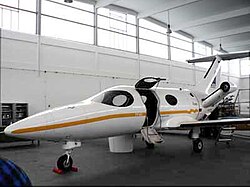HPA TT62
| HPA TT62 | |
|---|---|

|
|
| Type: | Business jet |
| Design country: | |
| Manufacturer: |
High Performance Aircraft GmbH & Co. KG |
| First flight: |
February 22, 2005 |
| Number of pieces: |
1 |
The HPA TT62 Alekto is a project for a twin-engine business aircraft from High Performance Aircraft GmbH & Co. KG (HPA), which was founded for this purpose and whose development was discontinued after the first flight due to the manufacturer's insolvency.
concept
The machine was built from carbon fiber reinforced plastic and is designed with a retractable nose wheel landing gear and a pressurized cabin . The main features of the machine were designed by the founder of the HPA, Heiko Teegen . The chief designer was Christian Majunke. The aim of the design was to develop a cost-effective business jet to be operated with kerosene ( Jet-A1 ) according to JAR-23 with a cruising speed of 230 KTAS for a sales price of around DM 750,000 . Options were finally offered on aircraft for EUR 450,000.
In order to achieve the goal, the two drive diesel engines were placed behind the cell. It was propelled by two adjustable five- blade propellers attached to pylons on the rear of the fuselage. These also carry the coolers. The tail unit is T-shaped.
history
The initiator of the project and company founder Heiko Teegen († August 5, 2003) was editor-in-chief of the magazine Pilot und Flugzeug . The company was founded in 2002 with considerable technology funding from the state of Mecklenburg-Western Pomerania . The company was based in Zirchow on the island of Usedom at Heringsdorf Airport .
The first flight of the machine with the aircraft registration D-IXTT , only about seven minutes long, took place on February 22, 2005 from Heringsdorf Airport. The aircraft was flown by the test pilot Gérard Guillaumaud . It turned out that the machine pulled on one side and could not achieve the calculated performance data. Extensive investigations were then carried out on the prototype. The cause of the unsatisfactory performance turned out to be an unforeseen interference between the wing, the propeller, the pylon supporting them and the tail unit.
Fundamental changes were required to correct the problem. The project went into a redefinition phase, which led to fundamental changes with the installation of the motors in the wing. The epithet of the project was changed from Alekto to Baltic (2/2006).
The HPA filed for bankruptcy in July 2006 .
The prototype of the TT62 was taken over by the Otto Lilienthal Museum on February 15, 2007 and has since been on display in the Aeronauticon, the open-air area of the museum at Anklam airfield .
Technical data (Alekto)
- Passengers: 5 + pilot 1
- Empty weight: 1780 kg
- Takeoff weight: 2550 kg
- Engine: 2 × TAE310 Thielert Centurion 4.0 , each with 228 kW (310 hp) at 3890 min -1 , V8 diesel, turbo charged, liquid-cooled
- Engine service life ( TBO ): 3000 h / 20 years (projected)
- Speed, max: 250 KCAS (projected)
- Cruising speed: 240 kn (projected)
- Fuel: Jet A
- Fuel load: 500 kg / 620 l (163 Gal)
- Consumption: 64 kg / h / economy flight: 4764 kg / h (projected)
- Propeller: 2 × 4-blade, fully adjustable, on two pylons with deflection gear
- Propeller speed: constant speed 2300 min −1
- Propeller diameter: 1.75 m
- Length: 11.68 m
- Height: 3.71 m
- Span: 11.24 m
- Wing area: 15.46 m²
- Wing loading: 182 kg / m² (31 lb / sqft)
- Hull diameter: 1.55 m
- Body length: 10.5 m
- Cabin length: 4.50 m
- Cabin width: 1.4 m
- Cabin: pressurized
- Autopilot: 3-axis (in the basic configuration)
swell
- ↑ Pilot and airplane 10/2005
- ↑ Pilot und Flugzeug online magazine (July 12, 2006)
- ↑ Internet presence of the Otto Lilienthal Museum